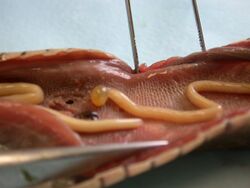Biology:Porocephalus crotali
| Porocephalus crotali | |
|---|---|

| |
| specimens infesting a snake Platyceps karelini | |
| Scientific classification | |
| Kingdom: | |
| Phylum: | |
| Subphylum: | |
| Class: | |
| Subclass: | |
| Order: | |
| Family: | |
| Genus: | Porocephalus
|
| Species: | P. crotali
|
| Binomial name | |
| Porocephalus crotali (Humboldt, 1808) [1]
| |
| Synonyms | |
| |
Porocephalus crotali is a parasitic crustacean from the group Pentastomida, also known as tongue worms.
Morphology
Porocephalus crotali is cylindrical and annulated (having ring-like segments) with 38–40 body segments, a digestive system, centrally located mouth surrounded by four hooks making it seem like it has five mouths — hence the name “pentastomes” .[3]
Life cycle
Mammals are the intermediate hosts and snakes are the definitive hosts.[4]
Once the larva is released from the egg, it enters the duodenal mucosa of the host. It takes about an hour from the time the egg is swallowed to the time there is complete entrance into the host. After entering the duodenal mucosa, the larvae travel to the abdominal cavity where it takes a week until the larvae molt is encapsulated in the host tissue. During a three-month period, the parasite continues to molt five more times in which the size increases and the body becomes segmented. The sex of the parasite can be determined after the fifth molt. When the sixth molt is complete, the nymphs become encapsulated and dormant. If a snake eats the nymph, the nymph loses its dormancy and quickly enters the intestinal wall of the snake where it travels to the lungs. They then feed on the blood and tissue fluids in the lungs until they reach maturity.[5]
Disease
The larval stages in the nymph may cause visceral pentastomiasis in humans .[3] Visceral pentastomiasis has been reported from Africa, Malaysia and the Middle East.
References
- ↑ "Porocephalus crotali". Integrated Taxonomic Information System. https://www.itis.gov/servlet/SingleRpt/SingleRpt?search_topic=TSN&search_value=682445.
- ↑ George H. Penn Jr. (1942). "The life history of Porocephalus crotali, a parasite of the Louisiana muskrat". The Journal of Parasitology 28 (4): 277–283. doi:10.2307/3272965.
- ↑ 3.0 3.1 Demnis Tappe & Dietrich W. Büttner (2009). Bethony, Jeffrey M.. ed. "Diagnosis of Human Visceral Pentastomiasis". PLOS Neglected Tropical Diseases 3 (2): 1–7. doi:10.1371/journal.pntd.0000320. PMID 19238218.
- ↑ M. D. Brookins; J. F. X. Wellehan; J. F. Roberts; K. Allison; S. S. Curran; A. L. Childress; E. C. Greiner (2009). "Massive visceral pentastomiasis caused by Porocephalus crotali in a dog". Veterinary Pathology 46 (3): 460–463. doi:10.1354/vp.07-VP-0246-R-BC. PMID 19176495. http://www.vetpathology.org/cgi/content/abstract/46/3/460?rss=1.
- ↑ Larry S. Roberts; John Janovy Jr. (2006). Foundations of Parasitology, 7th ed.. Singapore: McGraw-Hill. ISBN 978-0-07-234898-9.
Wikidata ☰ Q3809052 entry
 |

